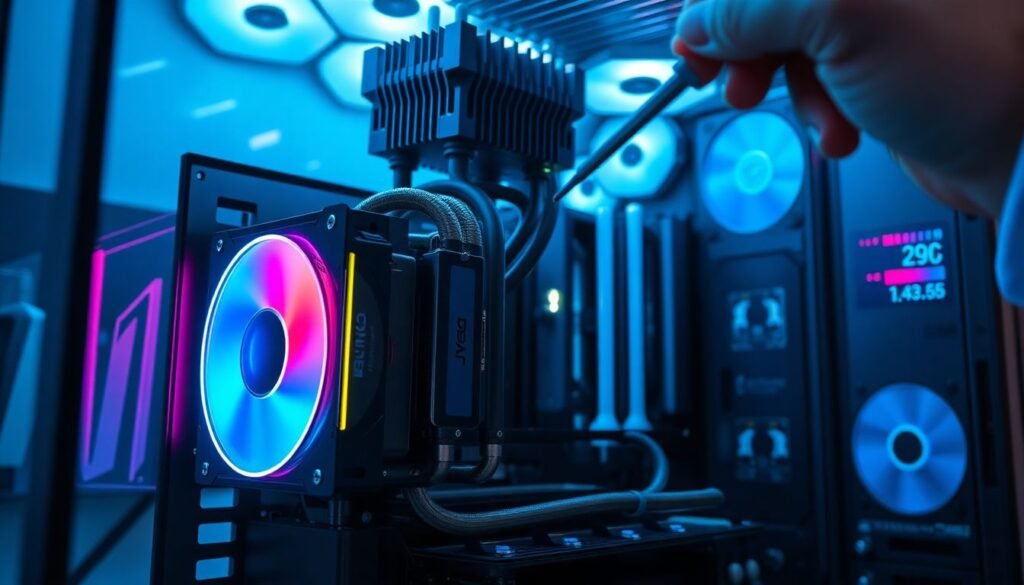
Introduction
A high-performance graphics card can push your PC to the limit. But without good cooling, it can overheat fast. That’s where liquid cooling comes in. It keeps your GPU cool, helps it last longer, and may even improve gaming or rendering speeds. More gamers and content creators are using custom loops or pre-made AIO (All-In-One) solutions. Finding the right cooler can seem tough, but understanding your needs make the choice easier.
Understanding Liquid Cooling for Graphics Cards
What Is Liquid Cooling and How Does It Differ from Air Cooling?
Liquid cooling uses water or coolant to lower your GPU’s temperature. Key parts include the water block, radiator, pump, and reservoir. The water block sits on the GPU chip, transferring heat to the liquid. The pump moves coolant through the system, and the radiator cools it down before cycling back. It’s like a mini radiator for your PC.
Compared to air cooling, liquid options often dissipate heat faster. They’re quieter too, because fans run at lower speeds. Overclockers love liquid cooling because it provides extra headroom for tweaking GPU speeds. Custom loops are built from scratch, giving full control over parts and looks. Pre-built AIO coolers are ready to install, simpler but less flexible.
Benefits of Liquid Cooling for GPUs
Liquid cooling significantly lowers GPU temperatures, helping it run smoother. That means less thermal throttling and better performance under heavy loads. It also gives you more room to overclock safely, which boosts frame rates and rendering quality. Plus, liquid coolers are usually quieter than traditional fans, so your gaming or work sessions are less noisy.
Common Misconceptions and Considerations
Many think liquid cooling is hard or dangerous. While it does need some planning, modern solutions are safer than ever. Leaks are rare if you pick quality parts. Maintenance can be simple—like checking for leaks or replacing coolant every year. Compatibility depends on your case size and GPU model; some cards need specific water blocks.
Key Features to Consider When Choosing a Liquid Cooler for Your Graphics Card
Compatibility with Your GPU Model
Not every liquid cooler fits every GPU. Check if the water block is designed for your specific model. Visiting the manufacturer’s website or forums helps. Popular GPUs like NVIDIA RTX 3080 or AMD RX 6900 XT often have verified cooling options. Make sure your chosen cooler will fit inside your case too.
Cooling Performance and Thermal Dissipation
Look for cooler specs like TDP (Thermal Design Power), which shows how much heat it can handle. A higher TDP rating means better cooling. Read reviews and comparisons to see how a product performs in real-world tests. Trusted benchmarks reveal if it keeps temperatures low during gaming or heavy tasks.
Ease of Installation and Maintenance
Pre-filled AIO coolers are easier to set up, often just plug-and-play. Custom loops demand more steps, like installing tubes, filling coolant, and leak testing. Maintenance varies but usually involves coolant checks and replacing fluid every year or so. Follow step-by-step guides or consider professional help if needed.
Build Quality and Material Durability
High-quality materials prevent leaks and last longer. Copper is excellent for heat transfer, while plastics like acetal or plexiglass add durability and style. Reputable brands use leak-proof fittings and high-grade components. Certifications like CE or UL indicate safety and quality.
Aesthetics and Customization Options
Many liquid coolers include RGB lighting, matching your PC’s look. Modular designs give you room to customize colors or features. If aesthetics matter, consider how the cooler matches your case and overall theme. Custom loops offer endless options but require more effort.
Budget and Cost-Effectiveness
Prices range from budget-friendly AIOs to expensive custom setups. Balance cost with performance and longevity. Cheaper coolers might save you money upfront but could need replacements sooner. Think of it as an investment—better cooling may extend your GPU’s life and boost performance.
Expert Recommendations and Top Brands
Trusted Brands and Their Offerings
Brands like EKWB, Corsair, NZXT, and Alphacool lead the market. Their products are reliable and well-tested. EKWB offers high-end custom parts, while Corsair and NZXT have popular AIO solutions that suit most users. Check their latest models for features that match your needs.
Comparison of Popular Liquid Cooling Solutions
Consider your budget and goals. EKWB’s custom loops have unmatched flexibility but cost more and need more setup. Corsair’s high-performance AIOs provide great cooling with less hassle. Cheaper options work well for casual users but might not last as long. Choose what fits your skill level and aims.
Additional Tips from Industry Experts
Don’t buy a cooler just because it looks flashy. Focus on specs and reviews. Avoid cutting corners—quality parts matter for safety and performance. Proper installation is key; even the best cooler won’t work well if improperly fitted.
How to Install and Maintain Your Liquid Cooler
Step-by-Step Installation Guide
Start by preparing your workspace. Remove your GPU from the PC for easier access. Install the water block carefully onto the GPU, securing it tightly. Mount the radiator inside your case, ensuring airflow is unobstructed. Connect the tubing, fill the system with coolant, and run leak tests for safety. Follow manufacturer instructions closely.
Maintenance Best Practices
Regularly check for leaks, corrosion, or build-up. Cleanup leaks immediately. Replace coolant every 12-18 months to prevent buildup. Keep the system clean and dust-free, and monitor temperatures regularly. Troubleshooting often involves checking fittings, fans, or coolant levels.
Conclusion
Picking the right liquid cooler for your graphics card comes down to compatibility, performance, and budget. Do thorough research and choose trusted brands for safety and durability. Prioritize your needs—whether it’s quiet operation, overclocking, or style—to find the best fit. Remember, a good cooling system not only toughens your GPU but keeps it humming longer. For best results, plan installation carefully, maintain regularly, and don’t hesitate to seek professional advice when needed. Keeping your GPU cool ensures top performance, smooth gameplay, and a longer lifespan for your hardware.